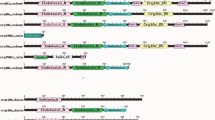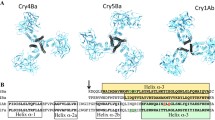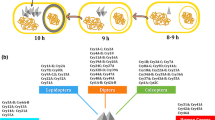Abstract
The theoretical three-dimensional structure of a novel δ-endotoxin Cry1Id (81 kDa) belonging to Cry1I class, toxic to many of the lepidopteran pests has been investigated through comparative modeling. Molecular dynamics (MD) simulations was carried out to characterize its structural and dynamical features at 10 ns in explicit solvent using the GROMACS version 4.5.4. Finally the simulated model was validated by the SAVES, WHAT IF, MetaMQAP, ProQ, ModFOLD and MolProbity servers. Despite low sequence identity with its structural homologs, Cry1Id not only resembles the previously reported Cry structures but also shares the common five conserved blocks of amino acid residues. Although the domain II of Cry1Id superpose well with its closest structural homolog Cry8Ea1, variation of amino acids and length in the apical loop2 of domain II was observed. In this work, we have hypothesized that the variations in apical loop2 might be the sole factor for providing variable surface accessibility to Cry1Id protein that could be important in receptor recognition. MD simulation showed the proposed endotoxin retains its stable conformation in aqueous solution. The result from this study is expected to aid in the development hybrid Cry proteins and new potent fusion proteins with novel specificities against different insect pests for improved pest management of crop plants.









Similar content being viewed by others
References
Aronson AL, Beckman W, Dunn P (1986) Bacillus thuringiensis and related insect pathogens. Microbiol Rev 50:1–24
Schnepf E, Crickmore N, Van Rie J, Lereclus D (1998) Bacillus thuringiensis and its pesticidal crystal proteins. Microbiol Mol Biol 62:775–806
Manimaran P, Ramkumar G, Mohan M, Mangrauthia SK, Padmakumari AP, Muthuraman P, Bentur JS, Viraktamath BC, Balachandran SM (2011) Bt rice evaluation and deployment strategies. GM Crops 2:135–137
Huang DF, Zhang J, Song FP, Lang ZH (2007) Microbial control and biotechnology research on Bacillus thuringiensis in China. J Invertebr Pathol 95:175–180
Pigott CR, Ellar DJ (2007) Role of receptors in Bacillus thuringiensis crystal toxin activity. Microbiol. Mol Biol Rev 71:255–281
Hofte H, Whiteley HR (1989) Insecticidal crystal proteins of Bacillus thuringiensis. Microbiol Rev 53:242–255
Knowles BH, Ellar DJ (1987) Colloid-osmotic lysis is a general feature of the mechanism of action of Bacillus thuringiensis δ-endotoxins with different insect specificity. Biochim Biophys Acta 924:507–518
Choma CT, Surewicz WK, Carey PR, Pozsgay M, Raynor T, Kaplan H (1990) Unusual proteolysis of the protein and toxin from Bacillus thuringiensis structural implications. Eur J Biochem 189:523–527
Hofmann C, Vanderbruggen H, Hofte H, Van Mellaert H (1988) Specificity of Bacillus thuringiensis delta-endotoxins is correlated with the presence of high-affinity binding sites in the brush border membrane of target insect midgets. Proc Natl Acad Sci USA 85:7844–7848
de Maagd RA, Bravo A, Berry C, Crickmore N, Schnepf HE (2003) Review Structure, diversity, and evolution of protein toxins from spore-forming entomopathogenic bacteria. Annu Rev Genet 37:409–433
Shelton AM, Zhao JZ, Roush RT (2002) Economic, ecological, food safety, and social consequences of the deployment of bt transgenic plants. Annu Rev Entomol 47:845–881
Gazit E, La Rocca P, Sansom MS, Shai Y (1998) The structure and organization within the membrane of the helices composing the pore-forming domain of Bacillus thuringiensis delta-endotoxin are consistent with an “umbrella-like” structure of the pore. Proc Natl Acad Sci USA 95:12289–12294
Li JD, Carroll J, Ellar DJ (1991) Crystal structure of insecticidal delta-endotoxin from Bacillus thuringiensis at 2.5 A° resolution. Nature 353:815–821
Schwartz JL, Lu YJ, Sohnlein P, Brousseau R, Laprade R, Masson L, Adang MJ (1997) Ion channels formed in planar lipid bilayers by Bacillus thuringiensis toxins in the presence of Manduca sexta midgut receptors. FEBS Lett 412:270–276
Boonserm P, Mo M, Angsuthanasombat C, Lescar J (2006) Structure of the functional form of the mosquito larvicidal Cry4Aa toxin from Bacillus thuringiensis at a 2.8 angstrom resolution. J Bacteriol 188:3391–3401
Gomez I, Arenas I, Benitez I, Miranda-Ríos J, Becerril B, Grande R, Almagro JC, Bravo A, Soberon M (2006) Specific epitopes of domains II and III of Bacillus thuringiensis Cry1Ab toxin involved in the sequential interaction with cadherin and aminopeptidase-N receptors in Manduca sexta. J Biol Chem 281:34032–34039
Bravo A (1997) Phylogenetic relationships of Bacillus thuringiensis delta-endotoxin family proteins and their functional domains. J Bacteriol 179:2793–801
de Maagd RA, Bravo A, Crickmore N (2001) How Bacillus thuringiensis has evolved specific toxins to colonize the insect world. Trends Genet 17:193–199
Guo S, Ye S, Liu Y, Wei L, Xue J, Wu H, Song F, Zhang J, Wu X, Huang D, Rao Z (2009) Crystal structure of Bacillus thuringiensis Cry8Ea1: An insecticidal toxin toxic to underground pests, the larvae of Holotrichia parallela. J Struct Biol 168:259–266
Crickmore N, Zeigler DR, Feitelson J, Schnepf E, Van Rie J, Lereclus D, Baum J, Dean DH (1998) Revision of the nomenclature for the Bacillus thuringiensis pesticidal crystal proteins. Microbiol Mol Biol Rev 62:807–813
Grochulski P, Masson L, Borisova S, Pusztai-Carey M, Schwartz JL, Brousseau R, Cygler M (1995) Bacillus thuringiensis CryIA(a) insecticidal toxin: crystal structure and channel formation. J Mol Biol 254:447–464
Morse RJ, Yamamoto T, Stroud RM (2001) Structure of Cry2Aa suggests an unexpected receptor binding epitope. Structure 9:409–417
Galitsky N, Cody V, Wojtczak A, Ghosh D, Luft JR, Pangborn W, English L (2001) Structure of the insecticidal bacterial-endotoxin Cry3Bb1 of Bacillus thuringiensis. Acta Crystallographica Section D: Biological Crystallography 57:1101–1109
Boonserm P, Davis P, Ellar DJ, Li J (2005) Crystal structure of the mosquito-larvicidal toxin Cry4Ba and its biological implications. J Mol Biol 348:363–382
Choi SK, Shin BS, Kong EM, Rho HM, Park SH (2000) Cloning of a new Bacillus thuringiensis cry1I-type crystal protein gene. Curr Microbiol 41:65–69
Gleave AP, Williams R, Hedges RJ (1993) Screening by polymerase chain reaction of Bacillus thuringiensis serotypes for the presence of cryV-like insecticidal protein genes and characterization of a cryV gene cloned from B. thuringiensis subsp. kurstaki. Appl Environ Microbiol 59:1683–1687
Tabashnik BE, Finson N, Chilcutt CF, Cushing NL, Johnson MW (1993) Increasing efficiency of bioassays: evaluation of resistance to Bacillus thuringiensis in diamondback moth (Lepidoptera: Plutellidae). J Econ Entomol 86:635–644
Gasteiger E, Gattiker A, Hoogland C, Ivanyi I, Appel RD, Bairoch A (2003) ExPASy: the proteomics server for in-depth protein knowledge and analysis. Nucleic Acids Res 31:3784–3788
Finn RD, Mistry J, Tate J, Coggill P, Heger A, Pollington JE, Gavin OL, Gunesekaran P, Ceric G, Forslund K, Holm L, Sonnhammer EL, Eddy SR, Bateman A (2010) The Pfam protein families database. Nucleic Acids Res 38:D211–222
Letunic I, Doerks T, Bork P (2009) SMART 6: recent updates and new developments. Nucleic Acids Res 37:D229–D232
Marchler-Bauer A, Lu S, Anderson JB, Chitsaz F, Derbyshire MK, DeWeese-Scott C, Fong JH, Geer LY, Geer RC, Gonzales NR, Gwadz M, Hurwitz DI, Jackson JD, Ke Z, Lanczycki CJ, Lu F, Marchler GH, Mullokandov M, Omelchenko MV, Robertson CL, Song JS, Thanki N, Yamashita RA, Zhang D, Zhang N, Zheng C, Bryant SH (2011) CDD: a Conserved Domain Database for the functional annotation of proteins. Nucleic Acids Res 39:D225–D229
Wei Y, Thompson J, Floudas CA (2011) CONCORD: A consensus method for protein secondary structure prediction via Mixed Integer Linear Optimization. Proc R Soc A. doi:10.1098/rspa.2011.0514
Sali A, Potterton L, Yuan F, van Vlijmen H, Karplus M (1995) Evaluation of comparative protein modeling by MODELLER. Proteins 23:318–326
Boratyn GM, Schaffer AA, Agarwala R, Altschul SF, Lipman DJ, Madden TL (2012) Domain enhanced lookup time accelerated BLAST. Biol Direct 7:12
Altschul SF, Madden TL, Schäffer AA, Zhang J, Zhang Z, Miller W, Lipman DJ (1997) Gapped BLAST and PSI-BLAST: a new generation of protein database search programs. Nucleic Acids Res 25:3389–3402
Ginalski K, Elofsson A, Fischer D, Rychlewski L (2003) 3D-Jury: a simple approach to improve protein structure predictions. Bioinformatics 19:1015–8
Wallner B, Larsson P, Elofsson A (2007) Pcons.net: protein structure prediction meta server. Nucleic Acids Res 35:W369–374
Kurowski MA, Bujnicki JM (2003) GeneSilico protein structure prediction meta-server. Nucleic Acids Res 31:3305–3307
Combet C, Jambon M, Deléage G, Geourjon C (2002) Geno3D: automatic comparative molecular modeling of protein. Bioinformatics 18:213–214
Roy A, Kucukural A, Zhang Y (2010) I-TASSER: a unified platform for automated protein structure and function prediction. Nat Protoc 5:725–738
Kelley LA, Sternberg MJE (2009) Protein structure prediction on the web: a case study using the Phyre server. Nat Protoc 4:363–371
Larkin MA, Blackshields G, Brown NP, Chenna R, McGettigan PA, McWilliam H, Valentin F, Wallace IM, Wilm A, Lopez R, Thompson JD, Gibson TJ, Higgins DG (2007) Clustal W and Clustal X version 2.0. Bioinformatics 23:2947–2948
Gouet P, Courcelle E, Stuart DI, Métoz F (1999) ESPript: multiple sequence alignments in PostScript. Bioinformatics 15:305–308
Brooks BR, Bruccoleri RE, Olafson BD, States DJ, Swaminathan S, Karplus M (1983) CHARMM: A Program for Macromolecular Energy, Minimization, and Dynamics Calculations. J Comp Chem 4:187–217
Walter RPS, Philippe HH, Ilario GT, Alan EM, Salomon RB, Jens F, Andrew ET, Thomas H, Peter K, Wilfred FG (1999) The GROMOS biomolecular simulation program package. J Phys Chem 103:3596–3607
Van Der Spoel D, Lindahl E, Hess B, Groenhof G, Mark AE, Berendsen HJ (2005) GROMACS: fast, flexible, and free. J Comput Chem 26:1701–1718
Darden T, Perera L, Li L, Pedersen L (1999) New tricks for modelers from the crystallography toolkit: the particle mesh Ewald algorithm and its use in nucleic acid simulations. Structure 7:R55–R60
Hess B, Bekker H, Berendsen HJC, Fraaije JGEM (1997) LINCS: A linear constraint solver for molecular simulations. J Comput Chem 18:1463–1472
Laskowski RA, MacArthur MW, Moss DS, Thornton JM (1993) PROCHECK-a program to check the stereochemical quality of protein structures. J App Cryst 26:283–291
Colovos C, Yeates TO (1993) Verification of protein structures: patterns of non-bonded atomic interactions. Protein Sci 2:1511–1519
Luthy R, Bowie JU, Eisenberg D (1992) Assessment of protein models with three-dimensional profiles. Nature 356:83–85
Pontius J, Richelle J, Wodak SJ (1996) Deviations from standard atomic volumes as a quality measure for protein crystal structures. J Mol Biol 264:121–136
Hekkelman ML, Te Beek TA, Pettifer SR, Thorne D, Attwood TK, Vriend G (2010) WIWS: a protein structure bioinformatics Web service collection. Nucleic Acids Res 38:W719–W723
Melo F, Devos D, Depiereux E, Feytmans E (1997) ANOLEA: a www server to assess protein structures. Proc Int Conf Intell Syst Mol Biol 97:110–113
Pawlowski M, Gajda MJ, Matlak R, Bujnicki JM (2008) MetaMQAP: a meta-server for the quality assessment of protein models. BMC Bioinformatics 9:403
Wallner B, Elofsson A (2003) Can correct protein models be identified? Protein Sci 12:1073–1086
McGuffin LJ, Buenavista MT, Roche DB (2013) The ModFOLD4 server for the quality assessment of 3D protein models. Nucleic Acids Res 41:W368–W372
Chen VB 3rd, Arendall WB, Headd JJ, Keedy DA, Immormino RM, Kapral GJ, Murray LW, Richardson JS, Richardson DC (2010) MolProbity: all-atom structure validation for macromolecular crystallography. Acta Crystallogr D Biol Crystallogr 66:12–21
Wiederstein S (2007) ProSA-web: interactive web service for the recognition of errors in three-dimensional structures of proteins. Nucleic Acids Res 35:W407–W410
Gelly JC, Joseph AP, Srinivasan N, de Brevern AG (2011) iPBA: a tool for protein structure comparison using sequence alignment strategies. Nucleic Acids Res 39:W18–W23
Takeshi K (2003) MATRAS: a program for protein 3D structure comparison. Nucleic Acids Res 31:3367–3369
Frishman D, Argos P (1995) Knowledge-based protein secondary structure assignment. Proteins 23:566–579
Kabsch W, Sander C (1983) Dictionary of protein secondary structure: pattern recognition of hydrogen-bonded and geometrical features. Biopolymers 22:2577–2637
Ikai AJ (1980) Thermostability and aliphatic index of globular proteins. J Biochem 88:1895–1898
Guruprasad K, Reddy BV, Pandit MW (1990) Correlation between stability of a protein and its dipeptide composition: a novel approach for predicting in vivo stability of a protein from its primary sequence. Protein Eng 4:155–161
Kroemer RT, Doughty SW, Robinson AJ, Richard WG (1996) Predictions of the three-dimensional structure of human interleukin-7 by homology modeling. Protein Eng 9:493–498
Tajne S, Sanam R, Gundla R, Gandhi NS, Mancera RL, Boddupally D, Vudem DR, Khareedu VR (2012) Molecular modeling of Bt Cry1Ac (DI-DII)-ASAL (Allium sativum lectin)-fusion protein and its interaction with aminopeptidase N (APN) receptor of Manduca sexta. J Mol Graph Model 33:61–76
Acknowledgments
This work was financially supported by the grant of Bioinformatics Initiative Division, Department of Electronics and Informatics Technology (DEITY), Ministry of Communications and Information Technology, Government of India. We also gratefully acknowledge the financial support by Biotechnology Information System Network (BTISNET), Department of Biotechnology, Government of India.
Author information
Authors and Affiliations
Corresponding author
Electronic supplementary materials
Below is the link to the electronic supplementary material.
ESM 1
(DOCX 1235 kb)
Rights and permissions
About this article
Cite this article
Dehury, B., Sahu, M., Sahu, J. et al. Structural analysis and molecular dynamics simulations of novel δ-endotoxin Cry1Id from Bacillus thuringiensis to pave the way for development of novel fusion proteins against insect pests of crops. J Mol Model 19, 5301–5316 (2013). https://doi.org/10.1007/s00894-013-2010-x
Received:
Accepted:
Published:
Issue Date:
DOI: https://doi.org/10.1007/s00894-013-2010-x




